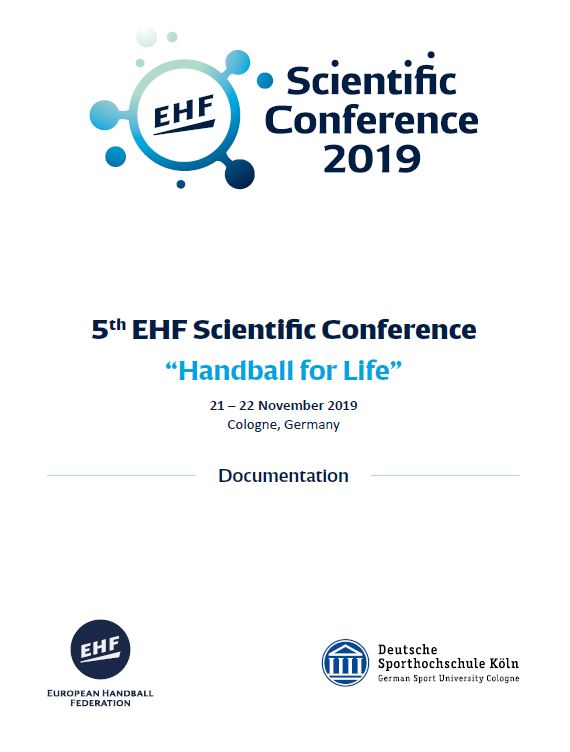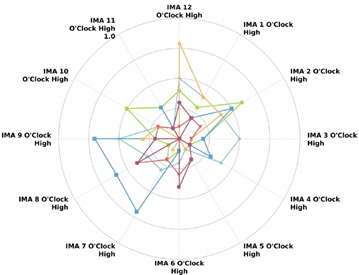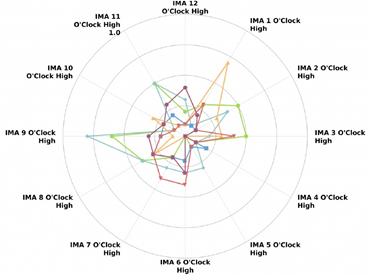Load parameters associated with qatch matches using microsensor technology
LOAD PARAMETERS ASSOCIATED WITH QATCH MATCHES USING MICROSENSOR TECHNOLOGY
Csaba Ökrös, PhD, University of Physical Education, Budapest, Hungary
Summary
The aim of this study was to measure the external and cardiovascular load during 4 Qatch matches using microsensor technology and compare it with previous results measured during team handball. The number of high-intensity events/minute was lower than in team handball (especially decelerations/minute), similarly to the cardiovascular load. The physical demands of Qatch are similar but somewhat lower than those of team handball.
Keywords: Qatch, team handball, external load, cardiovascular load
Introduction
Overview of the rules. Qatch is originated from various ball games including handball and is played on the Teqball table. There is a hexagon shaped line system consisting of baselines and sidelines. In this game, two teams of three players throw the ball back and forth to each other in an intense manner. Two players from the same team are at the same end of the table while the third player, the defender is at the opposite end among their opponents (Figure 1.). The defender starts the game with the opening throw by passing the ball to his teammates and it has to bounce once on the table before being caught by a teammate. During the opening throw the opposing players have to stay outside the hexagon, till the ball has been caught by the opponent. The opening throw alternates between the teams after every second valid rally. A minimum of 1 pass is required between teammates before returning the ball. Each team has a maximum of 3 passes to return the ball. Players are not allowed to dribble the ball. Bounce pass is allowed using the floor or the table. Players are allowed to hold the ball for maximum 3 seconds. Players are allowed to touch the ball with any body part including the legs as long as the ball has been thrown by the opponent. When returning the ball, the ball must bounce on the opponent’s playing side of the table. Once the ball is returned, the defender must leave the hexagon and go back to the baseline using the fastest route without blocking the opponent. Whilst returning the ball the thrower is not allowed to touch or cross the lines of the hexagon with any body part. Players are not allowed to land on or inside the lines of the hexagon after returning the ball unless it is an air shot. In that case landing on or inside the hexagon is allowed. Whilst returning the ball players are not allowed to touch or cross the centre line with any body part. In case of an infringement of any of these rules the team of the player that committed the foul receives a penalty point. If a team receives two penalty points in a game, the opposite team is awarded a penalty throw. During the penalty throw the thrower stands behind any of the sidelines and executes a direct shot on the table. Only one player from the opposing team is allowed to try to catch the ball. If the defending player catches the ball the play continues. If the defending player does not catch the ball and it hits the ground after it has hit the table, a point is awarded to the team that executed the penalty throw. If the thrower misses the penalty throw, no point is awarded and the play continues as normal. If the ball touches the edge of the table, the rally must be replayed. If the ball hits the side of the table (side ball) after a throw has been executed, the point is awarded to the opposing team. The “doublepoint” offers the opportunity for the teams to score two points instead of one in a single rally. The “doublepoint” can only be requested by a team once per set. It needs to be requested before the start of the rally. After every four valid rally the defenders need to be changed based on the rotating system. After each game teams need to change ends. A match is won by winning one or more sets based on the respective competition format. A set consists of two winning games. A game is won when a team reaches 8 points.
Aim of the study. As Qatch is a new and developing game, little is known about the physical demands of it. As the rules are adapted from team handball, we were investigating whether the external and cardiovascular load are comparable to those measured previously in team handball using microsensor technology.
Figure 1. Setup of Qatch before starting the game.
Methods
Subjects. Six physically active men took part in this study (age: 24,2 ± 3 years, height: 179 ± 4 cm, weight: 74 ± 6 kg). They were informed about the experimental design and gave their written consent to take part in the study.
Experimental overview. The players were invited to play 2 Qatch matches on two consecutive days in an indoor environment. After a standardised warm-up the two teams played two matches with one hour rest in-between. Each match consisted of two sets, each set broken down to three games. There was a 1-minute rest between the games and a 5-minute rest between the sets.
External load measurement. During matches, the players were equipped with a specially designed microsensor between the shoulder blades in a custom-made vest located under the jersey (Catapult T6, Catapultsports, Australia). Catapult T6 is an indoor local positioning system, using anchor nodes to determine the actual position of the players and provide locomotive data (total distance, high intensity distance, sprint distance, maximal velocity etc.). As Qatch is played in a very small area, we assumed that the locomotive load experienced by the players would be minimal, therefore we used the system without anchor nodes. In this case, the in-built microsensors (accelerometer, gyroscope, magnetometer) provide useful information about the mechanical load of the players at 100 Hz sampling frequency. By combining the information provided by the three microsensors, the unit orientation and direction can be determined, therefore high-intensity micromovements (accelerations, decelerations, changes of directions) can be captured. The start and end times of each games were recorded and based on that the rest periods have been excluded in Catapult Openfield Console software.
Data processing of external load measurement. Player LoadTM, accelerations (Acc), decelerations (Dec) and left/right changes of directions (CoD) were exported from Catapult Openfield Cloud using Inertial Movement Analysis (IMA). Player Load is derived from the accelerometer along the three axes (anterior-posterior, medio-lateral, upside-down) and characterises the overall workload of the player (Catapult, 2013). Player LoadTM is calculated as an instantaneous rate of change along the three axes and dived by 100 (Boyd et al., 2011). After integrating the raw microsensor data, Openfield uses an advanced Kalman filter to subtract the effect of gravity. Based on the direction of force applied the micromovements are categorized as accelerations (Acc), Decelerations (Dec), left or right changes of directions (Cod Left, Cod Right). Based on the change of velocity (m/s) the Acc, Dec and Cod have been categorised as low (1,5-2,5 m/s), medium (2,5-3,5 m/s) and high-intensity (>3,5 m/s) events. To ensure higher reliability, according to previous research medium and high intensity event counts have been taken together (Luteberget et al., 2018). According to this reliability study, the coefficient of variation for Player LoadTM was 0,9 %, for the IMA directions categorised into bands were between 2,9-5,6 %. Results are shown as mean±standard deviation.
Internal load. Maximal heart rate of the players has been determined during a 15 m shuttle test, in which the players had to run until volitional fatigue. Polar Team2 (Polar, Finland) heart rate belt were used to measure heart rate during the test. The maximal heart rate has been determined individually using the last stage of the shuttle run test. The maximal heart rate was 195 ± 1 bmp. In addition, mean heart rate (HRmean) as absolute value and percentage of the individual maximal heart rate was determined during Qatch matches. In addition, percentage of time spent in different heart rate zones based on maximal heart rate was also examined. Capillary blood lactate (mMol/L) was measured from the fingertip before the start, during the half time and two minutes after the end of each match using a portable analyser (Lactate Scout+, EKF Diagnostics).
Results
External load during Qatch matches.
Table 1. Average values of the accelerations, decelerations, changes of directions, jumps and high-intensity events for the players during the matches. Acc Med+High: the number of accelerations >2,5 m/s, Dec Med+High: the number of decelerations >2,5 m/s, Cod Left Med+High: the number of left changes of directions >2,5 m/s, Cod Right Med+High: the number of right changes of directions >2,5 m/s, Jump Med+High: the number of jumps >20 cm. HIE: high intensity events, the sum of accelerations, decelerations, left and right changes of directions.
Table 2. Average values of the accelerations, decelerations, changes of directions and jumps for the players during the matches normalized to net playing time. Acc Med+High/min: the number of accelerations >2,5 m/s per minute, Dec Med+High/min: the number of decelerations >2,5 m/s per minute, Cod Left Med+High/min: the number of left changes of directions >2,5 m/s per minute, Cod Right Med+High/min: the number of right changes of directions >2,5 m/s per minute, Jump Med+High/min: the number of jumps >20 cm per minute. HIE/min: high intensity events per minute, the sum of accelerations, decelerations, left and right changes of directions per minute.
Internal load during the matches. During the games one player did not have any heart rate data, therefore the internal load could be determined for 5 players only. The average heart rate during Qatch was 145 ± 15 bpm, which is 74 ± 7,5 % of the individual maximal heart rate of the players. The percentage of time spent in different heart rate zones are shown in Table 3. Lactate values are shown in Table 4.
Table 3. Percentage of total net playing time spent in different heart rate zones based on the individual maximal heart rate determined during a field test. e.g. % in HRmax 45-55 %: % of total playing time spent between 45-55 % of individual maximum heart rate.
Table 4. Capillary blood lactate values (mMol/L) before the start of each game (Pre), in the half time (Mid) and 2 minutes after the end of the games (Post).
Figure 2. High intensity micromovement profile of all players during the first match. Each colour represent a different player. In this schematic view the player stands in the centre of the circle facing 12 o’clock. Anything between 10,30-1,30 o’clock will be counted as high-intensity acceleration, between 1,30-4,30 as right change of direction, between 4,30-7,30 as deceleration and between 7,30-10,30 as left changes of direction. The closer is the coloured line to the time value, the more high-intensity micromovement happened in that direction.
Figure 3. High intensity micromovement profile of each player during the second match on the first day. Each colour represents a different player. In this schematic view the player stands in the centre of the circle facing 12 o’clock. Anything between 10,30-1,30 o’clock will be counted as high-intensity acceleration, between 1,30-4,30 as right change of direction, between 4,30-7,30 as deceleration and between 7,30-10,30 as left changes of direction. The closer is the coloured line to the time value, the more high-intensity micromovement happened in that direction.
Discussion
To the best of our knowledge this is the first study to examine the cardiovascular and external load during Qatch matches. The main finding were: 1) HIE/min was comparable but somewhat lower than during a handball game, 2) cardiovascular load (HRmean, time spent in different heart rate zones) was lower than during a handball game, 3) moderate lactate values indicate that anaerob lactic energy system also plays a role in Qatch, although during short rallies anaerobic alactic system might be the dominant energy system.
External load. There are only a few studies using inertial sensor technology to measure the mechanical load during team handball games. This technology allows to detect short, sharp accelerations, decelerations and changes of directions, which was not possible with previous tracking technologies (Luteberget et al., 2018). Qatch players executed 2,73 ± 0,5 high-intensity events, which is comparable but somewhat lower than previously suggested for elite Norwegian team handball players (Luteberget and Spencer, 2017). The Norwegian team handball players had 3,9 ± 1,58 HIE/min, even though their playing time was similar (33,2 min) to the net match time during Qatch.
If we examine the breakdown of the HIE, we can see that the biggest difference was in the number of decelerations per minute, as Qatch players executed a lot less from these actions than team handball players (0,7 ± 0,07 vs 2,3 ± 0,9). This finding needs further investigation. However, one should keep in mind that the subjects in our study were recreationally active men, which might explain partly the lower number of micromovements in comparison to world-class female handball players. Positional breakdown would also be interesting, however our limited sample size did not allow enough statistical power for this comparison. Luteberget and Spencer (2017) did not report the jumping data from the microsensors. In Qatch jump data might be more applicable, as the players are not allowed to touch the opponent, therefore it is less likely to land on the opponent’s feet than in team handball, which would the decrease the validity of the results. Qatch players jumped 0,46 ± 0,05 times per minute. Most of the jumps were moderate intensity (20-40 cm), but it still emphasizes the importance of lower limb power in this sport.
Internal load. Average heart rate during Qatch was 145 ± 15 bpm equalling 74 ± 7,5% of individual maximal heart rate. Previous studies suggested, that average heart rate is between 70-86 % of individual maximum in team handball, depending on gender, age and position (Karcher and Buchheit, 2014). More importantly, it often happens that the players spend >50 % of their playing time >80 % of their maximal heart rate, suggesting a high aerobic demand (Karcher and Buchheit, 2014). Qatch placed lower cardiovascular demands on the players, as 58,5 % of the match time was spent between 65-85 % of individual maximal heart rate even though the average heart rate was comparable to those in team handball. We could not determine the individual anaerobic threshold of the players, but the lactate measurements suggest that the anaerobic lactic system also plays an important role during Qatch. Still we assume that due to the relatively short rallies the anaerobic alactic system might be more important during the critical moments of the game and that is why we could not measure extremely high lactate values. The contribution of the different energy systems definitely needs some further investigation to optimise the physical preparation of Qatch players. The possible high importance of the anaerobic alactic system in Qatch might be an important similarity to team handball.
Limitations and future directions. Unfortunately, our subjects were not professional handball players, therefore we could not measure their cardiovascular and external load during team handball games. This could give us a better understanding about the match load in the same individuals during team handball and Qatch matches. The variability of physical output during team sport games (soccer) has been demonstrated previously (Gregson et al., 2010), therefore our limited sample size suggest that we need to be careful with the generalization of our results. It would also be interesting to measure female players during Qatch in comparison to team handball. We did not measure the locomotive load (total distance, high intensity distance, sprint distance, maximal velocity) of the players, as due to the limited playing area there is no space for the players to reach high velocities and cover long distances. Therefore, we think that the IMA based high-intensity events better describe the load imposed on the players during Qatch.
In conclusion, Qatch might be an interesting, alternative training method/game for team handball players to enhance their sport-specific abilities. However, these hypotheses definitely need further investigations using bigger sample size.








